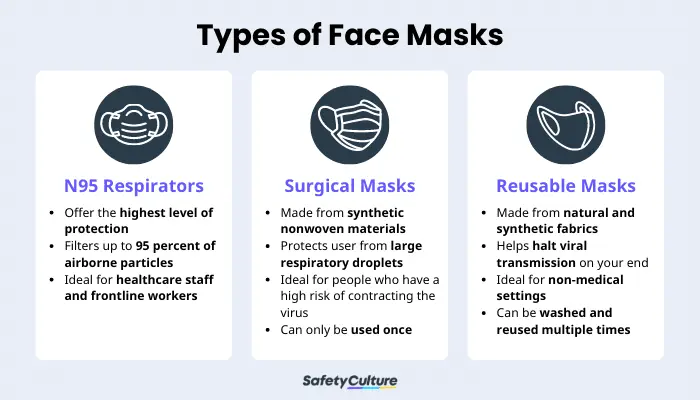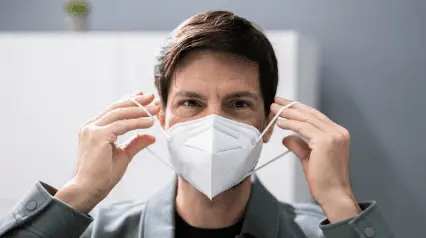What are Face Masks?
Face masks are critical protective equipment for COVID-19 prevention. They come in different types offering various levels of protection for every individual. When consistently worn the right way, they help shield the user from the virus. Face masks belong to a comprehensive set of COVID-19 solutions alongside physical distancing, proper handwashing, indoor ventilation, and other measures.
Types of Face Masks
Various face masks offer different levels of protection for its user. The key is to find a well-fitted one that suits your everyday needs, whether you’re a healthcare staff or an office worker.
This section lists three types of face masks and how to use them properly.

Types of Face Masks
N95 Masks and Other Respirators
Particulate respirators such as the KN95 and N95 masks offer the highest level of protection for its user. This mask contains specialized filters that trap harmful particles on its surface. It’s tailor-fitted for every user and creates a tight seal to reduce your exposure to airborne particles.
This mask type comes in different grades depending on its filtration rate and approval sources. For example, the US-made N95 masks can filter 95 percent of tiny particles. The National Institute of Occupational Safety and Health (NIOSH) is responsible for regulating its production and use. Other examples include the KN95 masks for China and FFP2 masks for Europe.
Best used for: N95 masks function as Personal Protective Equipment (PPE) for healthcare staff and frontline workers. They also protect caregivers of patients with confirmed or suspected COVID-19 infection.
Surgical Masks
A surgical mask consists of multiple layers of synthetic non-woven material and filters tucked in the middle. It provides an excellent defense against respiratory droplets. True to its name, this disposable medical mask is commonly used in surgical procedures and must be thrown in the trash bin after using it once.
This mask comes in varying levels of thickness, filtration, and fluid resistance. CDC recommends using it with a cloth mask for added protection.
Best used for: People over the age of 60 or with underlying health conditions can benefit from using disposable masks. It also works for people who are feeling mild symptoms of the virus.
Cloth Face Masks
A cloth face mask is the first thing that comes to mind when thinking of reusable face masks. True to its name, this mask is woven from natural and synthetic fabrics. Its multi-layered design helps stop the spread of the virus if you ever contract it.
Best used for: A cloth mask is ideal for everyday use such as grocery shopping and regular office work. Health experts recommend layering it with a surgical face mask for extra protection.
Health Guidelines
Quality face masks are an essential part of preventing the spread of COVID-19. Various health organizations have released health and safety standards for handling, storing, and making these face covers. This section discusses two pivotal protocols that you should know.
ASTM Standard on Face Masks
The American Society for Testing and Materials (ASTM) has set the standards for designing effective face masks. The ASTM F3502, endorsed by the NIOSH, outlines six characteristics that manufacturers should follow when making a face mask:
- It must cover the user’s mouth and nose.
- It should fit comfortably on the sides of the nose and face with no gaps.
- It should stay over the mouth and nose during prolonged use.
- It should use non-toxic materials that can irritate the skin.
- It should be designed for either single or multiple uses.
- It should fit or offer sizes for different kinds of individuals.
CDC Strategies for Optimizing the Supply of Face Masks
In the early stages of the pandemic, medical-grade mask supplies were running low because of the sudden increase in demand, panic buying, and hoarding. To resolve this, the US Centers for Disease Control and Prevention (CDC) released a set of strategies to optimize the use of face masks and other PPE supplies during shortages. Healthcare workers and leaders can refer to these methods in case of low supplies.
This guideline includes three capacity stages and their corresponding measures. Healthcare institutes must follow them for an optimal mask distribution. These stages are as follows:
Conventional Capacity Strategies
This stage sets the baseline for a healthcare facility’s overall capacity. At the conventional capacity, healthcare centers have an adequate supply of facemasks for their staff. Because of this, healthcare workers can proceed with the standard protocols for handling and discarding masks.
Contingency Capacity Strategies
The next step is the contingency capacity. At this level, healthcare facilities experience mask shortages at anticipated rates. By foreseeing the number of face masks needed, these facilities can employ the following temporary measures to mitigate the problem:
- Cancel select non-urgent procedures that require the use of face masks as PPE.
- Restrict distribution of facemasks only to patients who need them.
- Allow an extended use of facemasks as PPE.
Crisis Capacity Strategies
If the mask supply can’t meet the predicted rate, this is where the final capacity level comes in. Healthcare facilities must implement optimization measures to combat this crisis:
- Cancel all non-urgent appointments that require the use of face masks as PPE.
- Wear facemasks beyond recommended shelf life when taking care of patients.
- Let healthcare practitioners reuse facemasks for a limited time.
- Prioritize the use of facemasks for urgent patient care activities.
Choosing the Right Face Covering
With so many face masks available, it may be challenging to choose the best one for your needs. This list will help you narrow down your options for the right mask:
- Fitting. It must fit the mouth, nose, and chin comfortably without any gap near the eyes or sides. A snug fit helps prevent droplets from leaking in and out of the mask.
- Breathability. Apart from having a good fit, it’s also good to use a mask that you can breathe comfortably in. Some face masks may require you to take breaths with more effort, but they shouldn’t make it harder for you to do so.
- Filtration. Face masks come in different filters, depending on the type of mask you use. For example, N95 masks offer the highest level of filtration, making them ideal for high-risk settings such as hospitals. A combination of medical and cloth masks can also filter particles more effectively for healthy individuals.
- Material. For cloth face masks, it’s best to use finely woven fabrics that block light when held against a light source. Meanwhile, medical masks typically have synthetic materials with varying layers of protection. Make sure to check the label if it abides by the NIOSH standards.
Face Masks FAQs
The WHO provides an easy, step-by-step guide on properly wearing a face mask.
- Before using your face mask, sanitize your hands using alcohol or soap. You also need to wash them before and after taking your mask off.
- Inspect the face mask for any holes or tears on the surface.
- Wear your mask as needed. It must cover your chin, mouth, and nose. For surgical masks, make sure to have the white side on the inside.
- Pinch the wire on the nose if there’s a nose strap.
- When done using, take it off by the straps and place it in a clean breathable bag.
This will depend on the level of COVID-19 risk in your community and the current restrictions enforced. For example, people living in low-risk areas can opt to wear a mask based on their preference and personal risk level. But for areas with a high risk of COVID-19 spread, it’s best to always wear a face mask, especially in public places.
Apart from this, you also need to wear a face mask if you are:
- unvaccinated;
- immunocompromised;
- living with someone at high risk of contracting COVID-19; or
- taking care of someone who has contracted the virus.
According to CDC, N95 masks are designed for one-time use. But if there’s a shortage, like in early 2020, you can use them again provided they are properly handled. For this purpose, you can follow CDC’s guidelines on decontaminating and reusing N95 masks.
The CDC recommends replacing your face mask as soon as it gets dirty or wet. Continuing to wear a soiled mask can put you at risk of receiving respiratory droplets unknowingly. But if the face mask is in good condition, you should change it depending on the type of mask you’re using.
In the case of cloth face masks, you can reuse them as many times as you can if you keep them clean. The CDC recommends washing them at least once a day to remove any harmful microorganisms that can linger in the fibers.
On the other hand, disposable face masks should be discarded after using them once. As for N95 face masks, it’s best to check the label for instructions on how long you can wear them throughout the day.
The answer to this question will depend on the type of reusable mask you’re using.
For example, experts don’t recommend washing the N95 respirators because it strips off the static filter that traps airborne particles. Instead, keep them in a breathable bag for one to two days before using them again.
But if you’re using a cloth face mask, it’s best to wash them at least once a day or as soon as they become soiled. Doing so keeps it clean, minimizes any risk of contamination, and maximizes its effectiveness.
John Hopkins Medicine recommends washing the cloth mask by hand or machine with hot water. If you’re handwashing the mask, it’s best to scrub it for at least 20 seconds before letting it dry.




